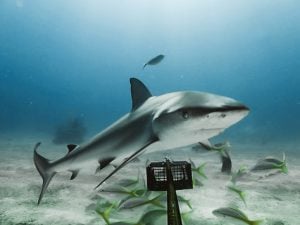
Wildlife
The great green shark hunt
Can British Columbia’s spiny dogfish make the grade as the world’s first “sustainable” shark fishery?
- 3319 words
- 14 minutes
This article is over 5 years old and may contain outdated information.
Wildlife

Canada is lined with three oceans, and sharks can be found off the coasts of all of them. In the nation’s fishing waters, 27 different species are commonly found. But before you go clambering toward landlocked Saskatchewan, remember that the chances of being attacked by a shark are extremely rare, especially in Canadian waters.
“Sharks have so much charisma; how could you not love them?” asks Daily Planet co-host Dan Riskin. Over the next six evenings, he and Ziya Tong will anchor Shark Week on Discovery Canada. Among the sharky adventures they’re excited to share: a cabinet full of goblin sharks, finding hammerheads at night, and the discovery of how exactly photographers capture the classic shark-jumping-out-of-the-water shot (unless they have “a horseshoe surgically implanted in their body,” Riskin says it takes a lot of planning.)
To kick off Shark Week, here are 10 facts about some of the sharks that swim in Canadian waters.
1. Greenland sharks are massive, and will eat almost anything. Two years ago two men in Newfoundland rescued one from choking on a moose, and in 2008 a polar bear jaw was found in a greenland shark’s stomach.
2. The spiny dogfish is a small schooling shark that’s been harvested for more than 100 years, and was initially used in the production of lamp oil, machine lubricant, and Vitamin A.
3. Legend has it that one of the world’s biggest [great] white sharks was accidentally trapped in a New Brunswick herring weir in the 1930s, but the purported length of 11.3 metres makes experts doubt whether it was in fact a white shark. According to the Canadian Shark Research Laboratory, one of the world’s largest accurately measured white sharks was a 5.2-metre female caught in 1983 off Prince Edward Island.
4. Canada’s largest shark is the basking shark. While it’s size and gaping maw might be off putting, don’t fear–it prefers plankton. Once considered to be a nuisance to Pacific commercial salmon fishing, basking sharks were targeted by a government eradication program from 1945-1970. It is now protected under Canada’s Species at Risk Act.
5. The porbeagle shark has a special trick wherein it can raise its body temperature three to eight degrees Celsius higher than the water around it, allowing it to move efficiently in the chilly North Atlantic. Unlike many other sharks the porbeagle must swim at all times in order to breathe.
6. The blue shark gets its name from–you guessed it–the colour of its flesh. A master of camouflage, its dark blue top blends in with the seas below, while it’s light belly makes the shark harder to see when looking up from below.
7. Most sharks’ vertebrae form growth rings, like trees. But Greenland sharks’ backbone offers no such clues, so scientists haven’t yet been able to determine the age of any specimens.
8. The world’s largest fish, the whale shark, prefers tropical and subtropical seas, but on August 22, 1997 one particular giant mysteriously found itself in the Bay of Fundy. It was the first and only recorded sighting.
9. Most modern sharks have five gills, but the bluntnose sixgill shark is among the very few that has, well, six. This is an ancient characteristic they may share with sharks from as far back as the Jurassic era.
10. The shortfin mako has been referred to as the “peregrine falcon of the shark world.” This open ocean sprinter can launch itself six meters into the air, and torpedo through the water at 35 kilometers per hour, though according to Discovery they’re believed able to reach speeds of up to 100 kilometers per hour (one of Daily Planet’s Shark Week episodes involves the slow-motion filming of the speedy predator.)
Are you passionate about Canadian geography?
You can support Canadian Geographic in 3 ways:

Wildlife
Can British Columbia’s spiny dogfish make the grade as the world’s first “sustainable” shark fishery?

Wildlife
Korean-Canadian filmmaker Sonya Lee dives deep into the world of great white sharks for the latest documentary from CBC’s The Nature of Things

Wildlife
Lead author Aaron MacNeil discusses what this means for coral ecosystems and what Canadians can do to help

Wildlife
Under Canadian leadership, the landing ban means more sharks will survive accidental capture — but is it enough?